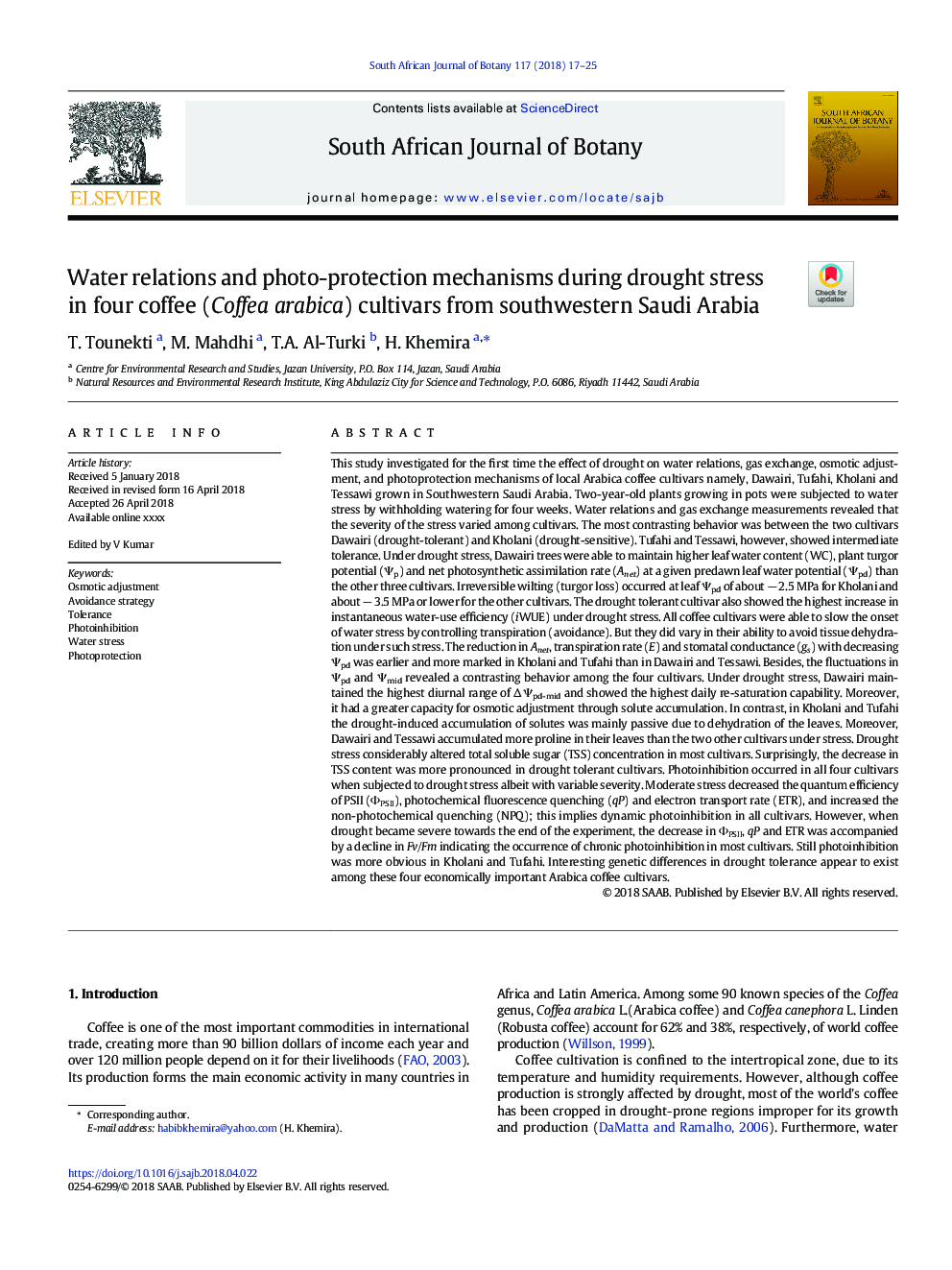| کد مقاله | کد نشریه | سال انتشار | مقاله انگلیسی | نسخه تمام متن |
|---|---|---|---|---|
| 8882238 | 1625141 | 2018 | 9 صفحه PDF | دانلود رایگان |
عنوان انگلیسی مقاله ISI
Water relations and photo-protection mechanisms during drought stress in four coffee (Coffea arabica) cultivars from southwestern Saudi Arabia
دانلود مقاله + سفارش ترجمه
دانلود مقاله ISI انگلیسی
رایگان برای ایرانیان
کلمات کلیدی
موضوعات مرتبط
علوم زیستی و بیوفناوری
علوم کشاورزی و بیولوژیک
علوم زراعت و اصلاح نباتات
پیش نمایش صفحه اول مقاله

چکیده انگلیسی
This study investigated for the first time the effect of drought on water relations, gas exchange, osmotic adjustment, and photoprotection mechanisms of local Arabica coffee cultivars namely, Dawairi, Tufahi, Kholani and Tessawi grown in Southwestern Saudi Arabia. Two-year-old plants growing in pots were subjected to water stress by withholding watering for four weeks. Water relations and gas exchange measurements revealed that the severity of the stress varied among cultivars. The most contrasting behavior was between the two cultivars Dawairi (drought-tolerant) and Kholani (drought-sensitive). Tufahi and Tessawi, however, showed intermediate tolerance. Under drought stress, Dawairi trees were able to maintain higher leaf water content (WC), plant turgor potential (Ψp) and net photosynthetic assimilation rate (Anet) at a given predawn leaf water potential (Ψpd) than the other three cultivars. Irreversible wilting (turgor loss) occurred at leaf Ψpd of about â 2.5â¯MPa for Kholani and about â 3.5â¯MPa or lower for the other cultivars. The drought tolerant cultivar also showed the highest increase in instantaneous water-use efficiency (iWUE) under drought stress. All coffee cultivars were able to slow the onset of water stress by controlling transpiration (avoidance). But they did vary in their ability to avoid tissue dehydration under such stress. The reduction in Anet, transpiration rate (E) and stomatal conductance (gs) with decreasing Ψpd was earlier and more marked in Kholani and Tufahi than in Dawairi and Tessawi. Besides, the fluctuations in Ψpd and Ψmid revealed a contrasting behavior among the four cultivars. Under drought stress, Dawairi maintained the highest diurnal range of â Ψpd-mid and showed the highest daily re-saturation capability. Moreover, it had a greater capacity for osmotic adjustment through solute accumulation. In contrast, in Kholani and Tufahi the drought-induced accumulation of solutes was mainly passive due to dehydration of the leaves. Moreover, Dawairi and Tessawi accumulated more proline in their leaves than the two other cultivars under stress. Drought stress considerably altered total soluble sugar (TSS) concentration in most cultivars. Surprisingly, the decrease in TSS content was more pronounced in drought tolerant cultivars. Photoinhibition occurred in all four cultivars when subjected to drought stress albeit with variable severity. Moderate stress decreased the quantum efficiency of PSII (ΦPSII), photochemical fluorescence quenching (qP) and electron transport rate (ETR), and increased the non-photochemical quenching (NPQ); this implies dynamic photoinhibition in all cultivars. However, when drought became severe towards the end of the experiment, the decrease in ΦPSII, qP and ETR was accompanied by a decline in Fv/Fm indicating the occurrence of chronic photoinhibition in most cultivars. Still photoinhibition was more obvious in Kholani and Tufahi. Interesting genetic differences in drought tolerance appear to exist among these four economically important Arabica coffee cultivars.
ناشر
Database: Elsevier - ScienceDirect (ساینس دایرکت)
Journal: South African Journal of Botany - Volume 117, July 2018, Pages 17-25
Journal: South African Journal of Botany - Volume 117, July 2018, Pages 17-25
نویسندگان
T. Tounekti, M. Mahdhi, T.A. Al-Turki, H. Khemira,